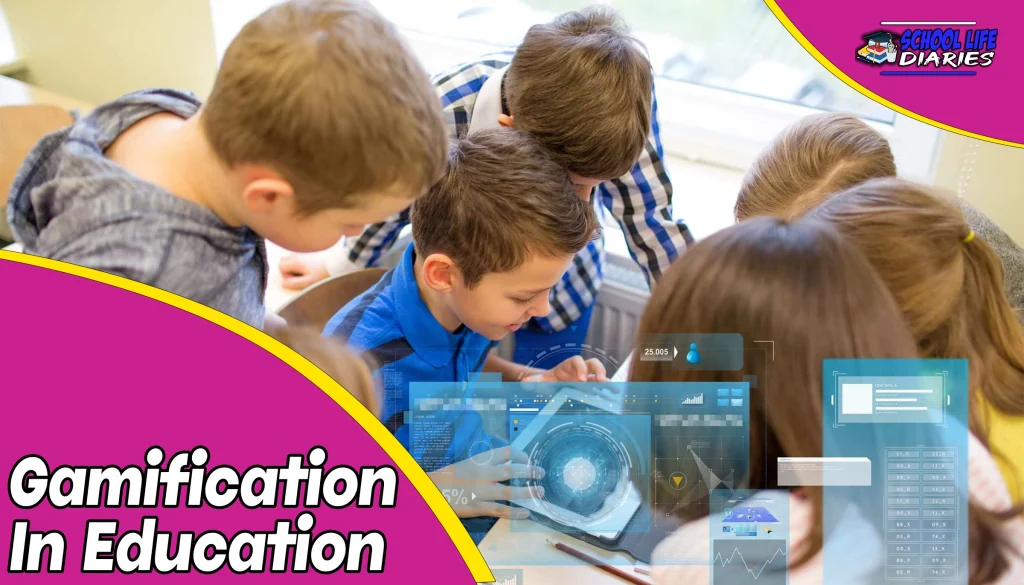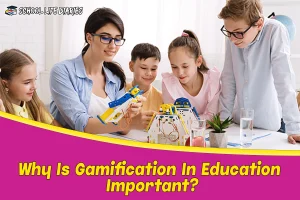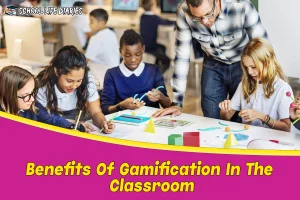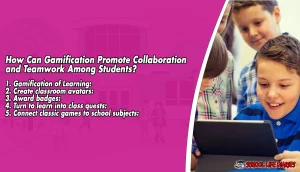Gamification is a buzzword that has gained traction in recent years, especially in the realm of education. It refers to the use of gaming elements and mechanics in non-game contexts, such as learning environments. The idea behind gamification is to make learning more engaging, interactive, and fun by incorporating game-like features into educational activities.
The potential benefits of gamification in education are numerous. Studies have shown that incorporating gaming elements into learning can lead to increased motivation, engagement, and participation among students. Additionally, it can enhance critical thinking skills, problem-solving abilities, and collaboration among learners.
In this article, we will explore some examples of gamification in education and discuss the benefits it offers for both students and teachers alike.
What Is Gamification In Education?
Gamification in education refers to the use of game-like elements in educational settings to enhance student engagement, motivation, and learning outcomes.
These game mechanics and design principles can include things like point systems, leaderboards, badges, and quests. The aim is to make learning more enjoyable and interactive by tapping into students’ natural desires for autonomy, mastery, and purpose.
There are several advantages to using gamification in education. First and foremost is increased student engagement. By making learning more fun and interactive, students are more likely to stay focused on the task at hand. Gamification also helps with knowledge retention by providing immediate feedback and reinforcing positive behaviors.
Finally, it can help prepare students for real-world scenarios by simulating decision-making processes in a safe environment. Despite its potential benefits, implementing gamification in education can be challenging. One of the biggest hurdles is designing effective game mechanics that align with educational goals.
Gamification has emerged as an innovative approach to enhancing student engagement and improving learning outcomes in educational settings. As we move forward into this new era where technology plays an increasing role in our daily lives – particularly among younger generations who have grown up surrounded by video games – we can expect further growth of this trend over time!
Why Is Gamification In Education Important?
The incorporation of interactive and engaging elements into the learning process can enhance student motivation, increase their retention of information, and foster a deeper understanding of complex concepts. The role of technology in this process has been significant as it offers various tools and platforms to create gamified learning experiences.
This approach promotes active participation by students, which leads to higher levels of engagement in the classroom.Student engagement is crucial for academic success.
Gamification strategies have proven to be effective in capturing students’ attention and making them more invested in their education. By integrating game-like features such as rewards, challenges, and leaderboards into academic tasks, educators can create an environment that promotes active learning while keeping students motivated.
Gamification is an innovative method that not only enhances student performance but also makes the learning experience enjoyable and memorable. It is no surprise that many institutions are incorporating gamification into their curriculum as it has become increasingly evident that this approach creates a dynamic educational environment that supports academic success.
What Are The Examples of Gamification In Education?
Incorporating game-like elements into the learning process has become increasingly popular in recent years, with various tools and platforms being utilized to create interactive educational experiences.
One example of gamification in education is the use of digital badges, which can be earned by students for completing certain tasks or demonstrating specific skills. These badges serve as a tangible reward for students’ achievements, while also encouraging them to engage more deeply with course content.
Another example of gamification in education comes from language learning apps like Duolingo. Through its use of colorful graphics and engaging exercises, Duolingo makes language learning feel like a game rather than a chore. This approach has been shown to increase student engagement and motivation, as well as improve overall retention rates.
Gamification can also be applied to real-life applications, such as financial literacy programs that simulate personal finance scenarios through games and simulations.
These types of programs allow students to apply their knowledge in practical ways while also reinforcing important educational goals around budgeting, saving, and investing. Overall, gamification has proven to be an effective tool for increasing student engagement and motivation while supporting key educational outcomes.
Benefits Of Gamification In The Classroom
Utilizing game elements in the classroom has been shown to have numerous advantages for both teachers and students alike. One of the most significant benefits is increased student engagement.
Gamification techniques are designed to make learning more interactive, which helps students stay focused and interested in the material being taught. By making learning fun, students are more likely to participate actively in class and retain information better.
Another benefit of gamification in education is personalized learning. Games can be tailored to individual student needs, allowing them to learn at their own pace and level.
This approach promotes self-directed learning, which can help students develop a sense of autonomy and confidence in their abilities. Additionally, personalized games can provide instant feedback on performance, giving students an opportunity to identify areas where they need improvement.
One of the most significant benefits of gamification is real-world applications. Games provide opportunities for the practical application of concepts learned in class by simulating real-life scenarios.
This type of learning enables students to see how concepts apply outside the classroom setting, providing them with a deeper understanding of how they can use what they’ve learned later on in life. Through gamification, teachers can create environments that mimic real-world situations while still offering a safe space for experimentation and growth.
What Are The Potential Challenges or Drawbacks of Implementing Gamification In Education?
Implementing game elements in the classroom may pose challenges related to designing effective and balanced games, ensuring alignment with learning goals, managing student motivation and behavior, addressing equity and inclusivity concerns, and evaluating the impact on learning outcomes.
One potential challenge is designing games that are both engaging and aligned with specific learning objectives. Games can be highly motivating for students, but if they do not support the intended learning outcomes or are poorly designed, they may actually hinder student progress.
Another challenge is managing student motivation and behavior. While gamification can increase engagement and motivation among students, it can also lead to distractions or off-task behaviors if not implemented properly.
Educators need to understand how to design effective games that support their curriculum goals, manage student motivation and behavior effectively within a gaming context, address equity concerns in game design, and evaluate the effectiveness of gamification on student learning outcomes. Without proper training, educators may struggle to implement gamification strategies effectively in their classrooms.
How Can Gamification Promote Collaboration and Teamwork Among Students?
Collaboration and teamwork can be fostered among students through the integration of game elements in the classroom setting.
Gamification provides a unique opportunity for teachers to incorporate brainstorming strategies into their lessons, promoting collaboration and idea-sharing among students. When students are engaged in gamified project-based learning, they are encouraged to work together to solve problems and complete tasks.
This type of learning creates an environment where students feel comfortable sharing ideas with their peers, leading to increased collaboration. In addition to promoting collaboration, gamification also encourages peer-to-peer feedback.
Students working together on a gamified project often provide feedback on each other’s work. This feedback can help improve the quality of work produced by individual students and promote teamwork skills. Peer-to-peer feedback encourages constructive criticism, which is essential for effective communication and successful teamwork.
This type of motivation also helps develop problem-solving skills as teams compete against one another to complete tasks or solve puzzles first.
Overall, integrating gamification into education has many benefits that promote collaboration and teamwork among students. Brainstorming strategies encourage idea-sharing while peer-to-peer feedback improves communication skills and fosters positive relationships between team members. Healthy competition promotes problem-solving skills while still encouraging cooperation within teams.
These benefits show how technology can be integrated effectively into education to create a positive learning experience for all involved parties involved in the process; teachers included.
1. Gamification of Learning:
Gamification of learning involves incorporating game elements into the classroom to enhance student engagement and motivation. One way to do this is by creating classroom avatars, which allow students to personalize their learning experience.
Another effective strategy is awarding badges as a form of recognition for achieving specific goals or milestones. Turning learning into class quests can promote collaboration and problem-solving skills among students. Connecting classic games to school subjects can make learning more enjoyable and memorable.
2. Create classroom avatars:
One potential approach to enhancing student engagement in the classroom is by utilizing avatars as a means of promoting personalization and interactivity within the learning environment. Avatar customization allows students to create a digital representation of themselves that reflects their unique personalities and interests.
This can help foster a sense of ownership over their learning experience, which may increase motivation and ultimately lead to improved academic performance. By incorporating personalized avatars into the classroom, teachers can create an interactive and engaging environment that encourages active participation from students.
Avatars can be used to facilitate group projects, discussions, and peer-to-peer collaboration. They can serve as visual aids during lectures or presentations, making complex concepts more accessible for visual learners.
Overall, the use of avatars in education has the potential to transform traditional classrooms into dynamic learning spaces that are tailored to meet student’s individual needs and preferences.
3. Award badges:
Awarding badges to students can be a powerful tool for recognizing and reinforcing positive behaviors and achievements in the classroom. Badges serve as a tangible representation of accomplishment, which can motivate students to strive for further success.
Design challenges that require creative thinking or problem-solving skills can be rewarded with badges, encouraging students to develop these important abilities. Furthermore, leaderboards provide a sense of competition that can push students to work harder and achieve more.
Point systems are another effective means of awarding badges, as they allow teachers to track progress over time. By assigning points for completing tasks or meeting specific goals, teachers can easily identify areas where individual students may need additional support or encouragement. Students who consistently earn points will feel pride in their accomplishments and become more engaged in their learning experiences overall.
4. Turn to learn into class quests:
Transforming classroom activities into class quests can enhance student motivation and engagement by providing a fun and interactive learning experience. Classroom adventures present students with exciting opportunities to apply their knowledge in a simulated environment that mimics real-world scenarios.
Role-playing lessons allow learners to take on different personas, encouraging them to think critically, communicate effectively, and collaborate with others.
Interactive simulations offer immersive experiences that enable students to explore complex concepts in a safe yet challenging setting. Class quests also provide instant feedback on performance, allowing learners to gauge their progress toward achieving specific learning goals.
This feedback loop enhances the intrinsic motivation of students as they receive immediate rewards for their efforts. Moreover, class quests promote healthy competition among peers as they strive to outperform one another while completing tasks and missions.
5. Connect classic games to school subjects:
Connecting classic games to school subjects can enhance student engagement and facilitate deeper learning experiences by providing a familiar and enjoyable context for content exploration. Classic game adaptations have been utilized in various ways across different academic disciplines.
For example, in history classes, students may explore historical events through the lens of popular strategy games such as Civilization or the Age of Empires. In language arts classes, students may analyze character development in classic literature by comparing it to role-playing games like Dungeons and Dragons.
Curriculum connections are crucial when incorporating classic game adaptations into classroom instruction. Teachers must ensure that the gameplay aligns with specific learning objectives and standards while maintaining an appropriate level of challenge for their students.
Is Gamification Effective?
Research has shown that gamification can be an effective tool to enhance engagement and learning outcomes in educational settings.
Effectiveness measures have been used to evaluate the impact of gamification on student performance, motivation, and satisfaction. These measures include academic achievement, retention rates, attendance, and participation. By incorporating game elements into educational activities, students are more likely to participate actively and remain focused on the task at hand.
This increased engagement can lead to improved academic outcomes as well as a greater sense of ownership over their own learning process. Implementation strategies also play a crucial role in the effectiveness of gamification in education. Additionally, teachers must provide clear instructions and feedback throughout the process to ensure that students understand how they can succeed within the game environment.
With proper implementation strategies in place, gamification can be a powerful tool for enhancing learning outcomes in educational settings.
Conclusion:
Gamification in education is a powerful tool that has the potential to engage and motivate students. It involves the use of game elements, such as points, badges, and leaderboards, to make learning more enjoyable and interactive. The benefits of gamification in the classroom are numerous.
It can enhance student engagement, promote collaboration and teamwork among students, increase motivation and retention rates, improve academic performance and outcomes, boost creativity and problem-solving skills, foster a sense of achievement and accomplishment, and provide instant feedback on progress or achievements.
These include potential distractions or disruptions in the classroom environment; increased pressure on teachers to create engaging content; lack of access to technology or resources needed for effective implementation. Despite these challenges, gamification is an effective approach to teaching that has been shown to produce positive results when implemented correctly.
In conclusion, gamification in education has emerged as an innovative way to engage students in learning activities. Its benefits are numerous but it does come with its own set of challenges that need to be addressed for successful implementation. With proper planning and execution by educators who understand its potential impact on student engagement and motivation levels – gamification can play a significant role in enhancing student learning outcomes while still making it fun.








